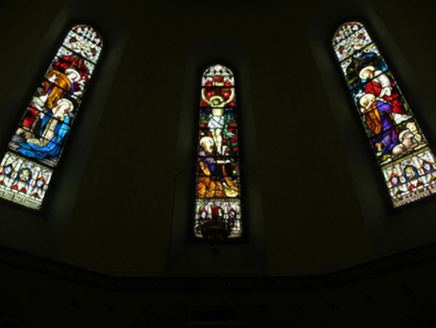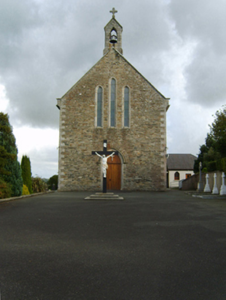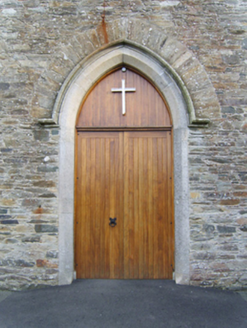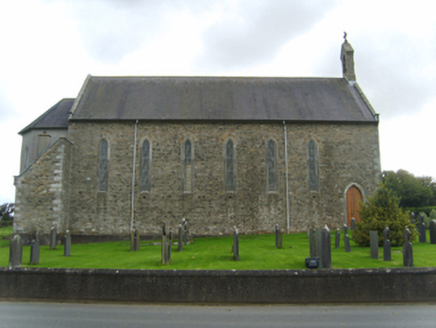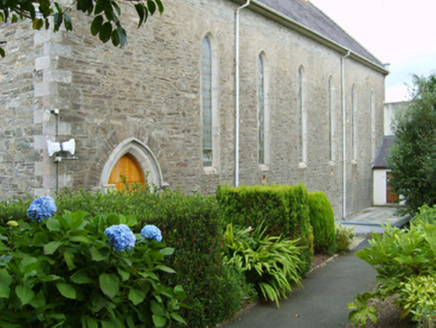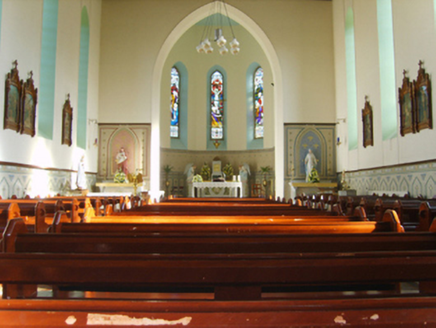Survey Data
Reg No
15700611
Rating
Regional
Categories of Special Interest
Architectural, Artistic, Historical, Scientific, Social
Original Use
Church/chapel
In Use As
Church/chapel
Date
1840 - 1845
Coordinates
308899, 159923
Date Recorded
28/09/2007
Date Updated
--/--/--
Description
Detached eight-bay double-height Catholic church, opened 1844, on a rectangular plan comprising seven-bay double-height nave opening into single-bay double-height apse (east) on a half-octagonal plan. Renovated, ----, with sanctuary reordered. Pitched slate roof; half-octagonal slate roof (east), clay ridge tiles, cut-granite "saddleback" coping to gables on cut-granite "Cavetto" kneelers including cut-granite "saddleback" coping to gable to entrance (west) front on cut-granite "Cavetto" kneelers with granite ashlar buttressed gabled bellcote to apex, and cast-iron rainwater goods on slightly overhanging eaves retaining cast-iron downpipes. Part repointed coursed rubble stone walls with benchmark-inscribed cut- or hammered granite flush quoins to corners; cement rendered surface finish (east) on cement rendered chamfered plinth. Lancet window openings with cut-granite surrounds having chamfered reveals framing fixed-pane fittings having stained glass margins centred on lattice glazing bars. Lancet window openings (east) with cut-granite surrounds having chamfered reveals framing storm glazing over fixed-pane fittings having leaded stained glass panels. Pointed-arch door opening to entrance (west) front, cut-granite surround having chamfered reveals with hood moulding framing replacement timber boarded double doors having overpanel. Lancet "Trinity Window" (gable) with cut-granite surrounds having chamfered reveals framing storm glazing over fixed-pane fittings having stained glass margins centred on lattice glazing bars. Pointed-arch opposing door openings (west), cut-granite surrounds having chamfered reveals with hood mouldings framing timber boarded or tongue-and-groove timber panelled double doors having overpanels. Interior including vestibule (west); square-headed door opening into nave with replacement glazed timber double doors having sidelights below overlight; full-height interior with tiled aisles between timber pews, mosaic tiled wainscoting supporting timber dado rail, paired Gothic-style timber stations between frosted glass windows, diagonal timber boarded ceiling in timber frame, and pointed-arch chancel arch framing mosaic tiled cut-veined white marble stepped dais to sanctuary (east) reordered, ----, with quatrefoil-panelled cut-veined white marble high altar in mosaic tiled surround below stained glass memorial windows (----). Set in landscaped grounds.
Appraisal
A church erected under the aegis of Reverend John O'Brien PP (1804-89; fl. 1841-69) representing an integral component of the mid nineteenth-century built heritage of north County Wexford with the architectural value of the composition, one evoking comparisons with the contemporary Catholic Church of the Assumption (1838-9) in Bree (see 15703116), suggested by such attributes as the compact rectilinear plan form, aligned along a liturgically-correct axis; the construction in unrefined local fieldstone offset by silver-grey granite dressings demonstrating good quality workmanship; the slender profile of the openings underpinning a "medieval" Gothic theme; and the handsome bellcote embellishing the roofline as a picturesque eye-catcher in the landscape: meanwhile, aspects of the composition, in particular the polygonal apse, clearly illustrate the continued development or "improvement" of the church at the turn of the twentieth century. Having been well maintained, the elementary form and massing survive intact together with substantial quantities of the original fabric, both to the exterior and to the interior reordered (----) in accordance with the liturgical reforms sanctioned by the Second Ecumenical Council of the Vatican (1962-5) where contemporary joinery; restrained mosaic work; and vibrant stained glass attributable to Franz Mayer and Company (founded 1847) of Munich and London, all highlight the artistic potential of a church forming part of a self-contained group alongside an adjacent presbytery (see 15700612) with the resulting ecclesiastical ensemble making a pleasing visual statement in a rural village street scene.
